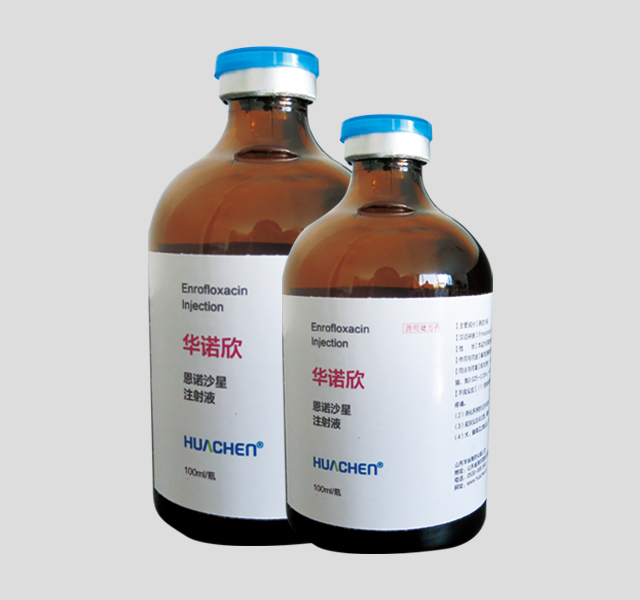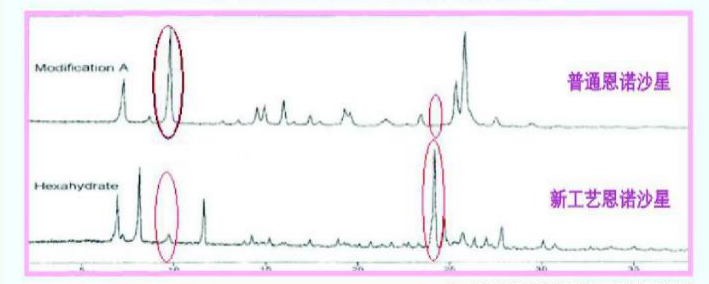
Fluoroquinolones are synthetic new antibacterial drugs, which are called fluoroquinolones because of their chemical structure containing fluorine atoms. Enrofloxacin, also known as enflurazine carboxylic acid, is a broad-spectrum antibacterial drug for animals. Enrofloxacin is a concentration-dependent antibiotic according to pharmacokinetic/pharmacodynamic classification.
【Function and use】
Enrofloxacin is a broad-spectrum antibacterial drug, which has strong effects on Gram-positive bacteria and Gram-negative bacteria, and has special effects on various mycoplasma. Its antibacterial activity is significantly better than norfloxacin, and its antibacterial effect against mycoplasma is stronger than that of tylosin and tiamulin. It has bactericidal effect on Escherichia coli, Klebsiella, Salmonella, Proteus, Pseudomonas aeruginosa, Haemophilus, Pasteurella multocida, Pasteurella hemolyticus, Staphylococcus aureus, Streptococcus, etc.; It is also effective against Chlamydia, but it is not effective against anaerobic bacteria, molds, viruses and parasites.
The minimum inhibitory concentration (MIC) of enrofloxacin is close to the minimum bactericidal concentration (MBC). Foreign studies have shown that the average MIC of enrofloxacin for most Gram-negative bacteria is generally less than 0.25 μg/ml, and the average MIC for Staphylococcus aureus, various Streptococcus, and Pseudomonas aeruginosa is 0.75 μg/ Ml, the average MIC of erysipelas and mycoplasma was 0.06 μg/ml.
Table 1 Minimum inhibitory concentration (MIC) of enrofloxacin
Pathogen | Number of strains | MIC(μg/ml) | |||
Range | Average | ||||
Gram-negative bacteria | |||||
E.coli | 178 | 0.01-0.5 | 0.06 | ||
Salmonella | 115 | 0.003-0.5 | 0.03 | ||
Yersinia | 5 | 0.01-0.04 | 0.01 | ||
Haemophilus | 23 | 0.02-0.5 | 0.02 | ||
Pasteurella multocida | 78 | 0.002-0.12 | 0.008 | ||
Hemolytic bacillus | 52 | 0.008-0.12 | 0.06 | ||
Various actinomycetes | 8 | 0.02-0.3 | 0.03 | ||
Pseudomonas | 41 | 0.25-2.0 | 0.75 | ||
Brucella | 3 | 0.1-4.0 | 0.5 | ||
Bordetella bronchiseptica | 31 | 0.1-4.0 | 0.5 | ||
Gram-positive bacteria | |||||
Staphylococcus aureus | 135 | 0.03-1.0 | 0.12 | ||
Various streptococcus | 61 | 0.06-4.0 | 0.75 | ||
Listeria monocytogenes | 5 | 1.0-2.0 | 1.75 | ||
Erysipelas bacillus | 6 | 0.06-0.1 | 0.06 | ||
Corynebacterium pyogenes | 29 | 0.06-4.0 | 0.75 | ||
Clostridium perfringens | 33 | 0.2-2.0 | 0.5 | ||
Mycoplasma | 92 | 0.01-1.0 | 0.25 | ||
Mycoplasma gallisepticum | 25 | 0.0125-0.1 | 0.1 | ||
*Mycoplasma gallisepticum | 6 | 0.02-1.0 | 0.1 | ||
*Chicken synovial mycoplasma | 1 | 0.1- | - | ||
** Chicken synovial mycoplasma | 1 | 0.1- | - | ||
Mycoplasma hyopneumoniae | 28 | 0.05-0.78 | 0.1 | ||
* Strains resistant to tylosin
**Strains resistant to tiamulin
【Pharmacokinetics】
This product is easy to absorb by oral administration, intramuscular injection and subcutaneous injection. The blood concentration reaches the peak in 0.5~2 hours, and the peak concentration of drug in blood and tissue is several times to several tens of times higher than the MIC of most bacteria and mycoplasma. It lasts for 4-6 hours; the drug is widely distributed in the body. Except for the central nervous system, the concentration of drugs in other tissues is almost higher than that of blood, especially in the lung and genitourinary tract. The bioavailability of enrofloxacin in pigs during intramuscular injection was 91.9%.
Enrofloxacin can de-ethylate in the body, and the main active metabolite produced is ciprofloxacin. However, there are great differences in metabolism between animals, and the metabolic rate in poultry, dogs, rabbits and cattle is high. The metabolic rate in horses and pigs is low. Since ciprofloxacin has stronger antibacterial activity against various pathogenic bacteria in livestock and poultry than enrofloxacin, both enrofloxacin and ciprofloxacin should be considered in estimating the activity of enrofloxacin in plasma and tissues concentration. The combined effect of enrofloxacin and the metabolite ciprofloxacin in animals is the greatest feature of the drug, but the amount of enrofloxacin metabolized to ciprofloxacin in pigs is negligible.
Enrofloxacin is a concentration-dependent antibiotic with a significant Post-antimicrobial effect (PAE) on both Gram-positive and Gram-negative bacteria. The higher the drug concentration, the longer the PAE. This product is exposed to the following bacteria for 2h with twice the MIC. The PAE is 1.94h for Pasteurella, 1.95h for Bordetella bronchiseptica and 3.29h for Actinobacillus pleuropneumoniae, which can better consolidate the curative effect.
【Mechanism of action】
It has a unique antibacterial mechanism and can bind to the bacterial DNA gyrase subunit A, thereby inhibiting the cleavage and ligation function of the enzyme, preventing the replication of bacterial DNA, and exhibiting selective bactericidal action.
【Indication】
Enrofloxacin can be used to treat skin infections, urinary tract infections, digestive and respiratory infections, and wound infections.
1. The efficacy of piglet yellow and white diarrhea, piglet edema disease, and salmonellosis (also known as piglet paratyphoid) is exactly.
2. Significant efficacy in systemic diseases such as streptococcosis, staphylococcal disease, and porcine erysipelas.
3. It has excellent effects on respiratory diseases such as atrophic rhinitis, swine asthma (mycoplasmal pneumonia), haemophilus parasuis, and actinobacillus pleuropneumonia.
4. Good for mastitis, mastitis, and milk-free syndrome (sow-free syndrome).
5. Enrofloxacin combined with oral rehydration salts for the treatment of exudative dermatitis in piglets.
【Medicine interactions】
Enrofloxacin has no cross-resistance with other antibiotics (except fluoroquinolones), but in order to avoid the emergence of drug resistance, it can be combined.
1. Combined with β-lactam antibiotics, aminoglycoside antibiotics or sulfonamides, synergistic antibacterial effect, but should be injected separately.
2. Enrofloxacin injection and sulfamonomethoxine sodium injection are administered intramuscularly once a day for 3 days, which has a good therapeutic effect on swine local pneumonia.
3. In combination with tetracyclines, furans, roxithromycin, aminophylline, and metal cations, it can reduce or antagonize efficacy.
【Huanuoxin features】
1. Unique spatial arrangement: the same chemical nature and different pharmacological properties. Due to different spatial arrangement, high-efficiency sterilization without drug resistance, clinical efficacy is significantly better than ordinary enrofloxacin. Bioavailability is twice that of ordinary domestic preparations.

Fig 1 Comparison of X-ray diffraction patterns of new process enrofloxacin and common enrofloxacin
It can be seen from Figure 1 that the difference between the new process enrofloxacin and ordinary enrofloxacin in spatial arrangement.
2. Different crystal forms: crystal particles are relatively uniform in size, regular in arrangement, uniform in distribution, and fast and complete in absorption. The peak plasma concentration is reached at 0.5h, and the bioavailability is twice that of ordinary enrofloxacin..

Figure 2 Scanning electron micrograph of the new process enrofloxacin and common enrofloxacin
3. Unique functional additives: keep the dominant crystal form of enrofloxacin from becoming ordinary crystal form, and have synergistic effect, ensuring the quality and efficacy of the product, high blood concentration, wide tissue distribution, mild clinical application without irritating.
4. Unique targeted slow release technology

Figure 3 The affinity for pathogens is more than 100 times the affinity for animal cells.
Table 2 Comparison of Huanuoxin and its ordinary enrofloxacin
Items | Huanuoxin | Ordinary Peoducts | Targeted product |
Raw material | Superior crystal form, unique spatial arrangement | Ordinary crystal form, irregular arrangement | Superior crystal form, unique spatial arrangement |
Crystal particles | Uniform particle size, regular arrangement, uniform distribution | Different shapes, disordered arrangement, particle size difference 5~7 times | Uniform particle size, regular arrangement, uniform distribution |
Buffer stabilizer | Unique buffer, milder, less irritating, no discomfort | Alkaline cosolvent, irritating, uncomfortable | Unique buffer, milder, less irritating, no discomfort |
Bioavailability | High, more than twice the size of ordinary enrofloxacin | Low | High, more than twice the size of ordinary enrofloxacin |
Sterilization effect | Lung targeted slow release, no drug resistance, rapid and thorough sterilization | Strong drug resistance | Lung targeted slow release, no drug resistance, rapid and thorough sterilization |
【Usage and dosage】
Intramuscular injection, one dose, based on enrofloxacin, 5mg/kg body weight, or 1ml/20kg body weight, no more than 2.5ml per injection site. If the injection volume is relatively large, it needs a point injection.
1. Generally bacterial infections in commercial pigs: 1ml/20kg body weight, intramuscular injection, once a day for 2~3 days. If the pig has a small body weight, it can be diluted 5 to 10 times with water for injection and the injection is more accurate.
2. Respiratory diseases and serious infections with salmonellosis: 1.5ml/20kg body weight, intramuscular injection, once a day, for 3 to 4 days. If the pig has a small body weight, it is more accurate after the injection is diluted 5-10 times with water for injection.
3. Treatment of sows with metritis, mastitis and lactation disorder syndrome: Within 8 hours of prenatal or postpartum, each sow is injected with Huanuoxin 6~8ml (6ml of first-born sows and 8ml of sows) to prevent postpartum infection and no milk syndrome, reducing the chance of early infection of piglets.
【Adverse reactions】
1. Affects the development of bones in young animals and causes lameness and pain;
2. The digestive system responds to loss of appetite, vomiting and diarrhea;
3. Skin erythema, itching, urticaria and photosensitivity.
【Precautions】
1. Intramuscular injection has a irritating effect;
2. Patients with renal insufficiency should be used with caution;
3. This product is not suitable for horses. It is not applicable to puppies before 8 weeks of age.
4. In order to reduce the development of drug resistance, it should not be used for a long time in sub-therapeutic doses.
Withdrawal time: Pig 10days
Storage: Protected from light and sealed
Packing specification: Specification: 100g: 10g
Packing: 100ml / bottle, 40 bottles / box